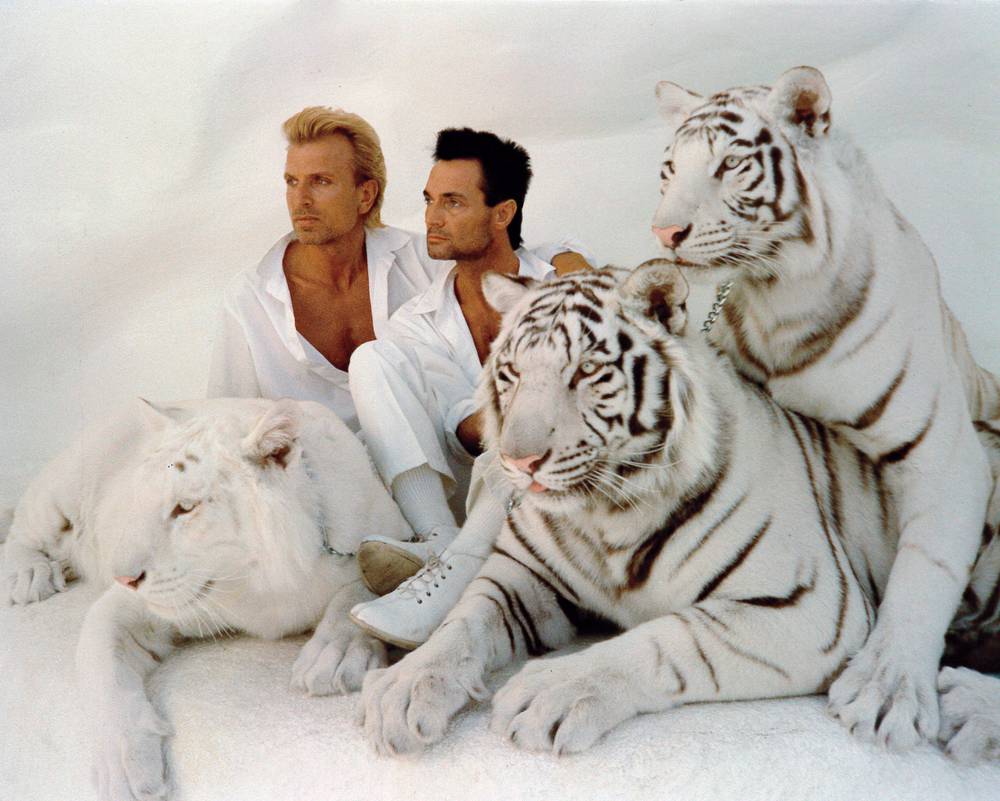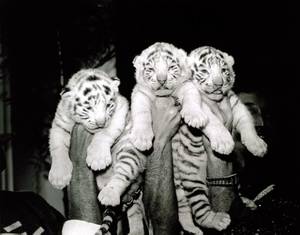Siegfried & Roy: 10 Years Later
Editor's note: Montecore, a white tiger featured in Siegfried & Roy's long-running production at the Mirage, passed away March 19, 2014. "The world has lost one of its most majestic creatures and I have lost a brother," Roy Horn said in a statement released March 25, continuing on to reflect on the night Montecore nearly took his life. "I will forever believe it was his concern for my safety and well-being that caused him to act as he did on that night long ago." In this story, columnist Steve Friess remembers the night that ended the Vegas legends' 35-plus-year run on the Las Vegas Strip.
The night Las Vegas changed forever, I was taking in a God-awful local theater version of Hedwig and the Angry Inch at some strip-mall shoebox where all the furniture had been requisitioned at local Goodwills or, more likely, dumpsters. This being 2003, performances of edgy LGBT-ish fare were still rare in these parts, so gays of all denominations felt obligated to attend, which is why the moment the show ended and people turned their devices back on, phones and, yes, pagers started beeping all over the place.
I don’t remember everyone who was there that night, but I do know there were some prominent publicists and executives from what at the time was known as MGM Mirage. And then there was John Wilson, co-founder of the region’s dominant ambulance service, next to whom I was standing as he spoke to his dispatchers over the phone. I heard some key words: Mirage. Tiger. Roy. Siegfried. Hospital.
He hung up, turned to whoever was near, and in a mutter of shock, said, “You’re never going to believe this.”
Even now, it remains hard to digest. On October 3, 2003, a 380-pound white tiger named Montecore nearly killed his beloved master, the illusionist Roy Horn, onstage in front of thousands of patrons. It was a traumatic, gory news event, the primary focus of which was the fate of Horn. In the week that followed, as he lingered between life and death only to be saved by a heroic but wild surgery that involved removing a piece of his skull and storing it in his abdomen until his cranial swelling subsided, the victim’s status largely dominated the story.
With the hindsight of a decade, it’s somewhat more clear that night is a line of demarcation, an unplanned if inevitable pivot in Las Vegas history of unprecedented and never-repeated significance. There had been high-profile murders and deaths, of course, that altered the world of politics, the Mob and the music industry writ large. There were casino closures and openings that represented turning points, but they were all reasonably well telegraphed and hyped. More onstage accidents would happen, too, even resulting in death, but those shows would, eventually, go on and on and on.
The Siegfried & Roy show, of course, did not. It ceased to exist in an instant, and with it an entire genre of Las Vegas entertainment was replaced. Some would suggest that this was inevitable, that the duo was getting on in years and bound to abdicate the gigantic marquee, but nobody associated with the production felt that way. I had a short-lived fling with one of the show’s dancers, and that September he was just finishing up his business degree at UNLV. His plan was to stuff the degree in his back pocket for a few years because “I’ve got a job that I can keep as long as I want it.” The job vanished a couple weeks later, and he vanished days after his December graduation to perform on a cruise ship somewhere.
It would be too simple to say the tiger attack short-circuited the era of garish Vegas shows featuring dangerous animals. They did kick around for a little after, mostly in the form of journeyman illusionist Rick Thomas, who now largely tours around Europe, according to his website. Today, they don’t really exist in any serious way on the Strip.
But it’s much more than that. There is a direct connection between the loss of Siegfried & Roy and the accelerated rise of Cirque du Soleil. Remember, one reason Cirque became so popular and buzzy in the first place was that it was a circus without animals or name-brand stars—two variables that made an act like Siegfried & Roy especially vulnerable to disaster. (The rise of Broadway, too, can be seen as a post-S&R risk-averse strategy, one that deployed famous concepts but not, in the long term anyway, famous people.)
When Montecore attacked Roy, Vegas had two juggernaut Cirque shows—O and Mystère—and one struggling new one, Zumanity. KÀ was on its way, but that seemed the outer limit of Cirque occupation on account of its exclusive relationship with MGM Mirage and the scarcity of showrooms. KÀ would struggle, too, so big investments in further Cirque productions were not automatic.
Yet if you’re MGM Mirage and you’ve just endured a horrific, expensive, very public catastrophe, you want to invest in something that can’t collapse in the blink of an eye. And so we got Love, an instant hit that renewed Cirque’s momentum, then, Criss Angel Believe, Viva Elvis, Michael Jackson One and now the Viva Elvis replacement, Zarkana, which played in New York City, Moscow and Madrid before landing in Las Vegas. Intriguingly, Cirque’s only star vehicle involving an actual living performer was also its last; Angel’s messy, mercurial, embarrassing behavior in his show’s early years reminded MGM and Cirque of the sort of uncontrollable variable they’d be wise to avoid.
The media and its relationship to Vegas changed, too, that night. The Celebrity Journalism Industrial Complex suddenly realized Las Vegas was a hotbed of star drama and one that was yet to be oversaturated as Los Angeles and New York already were. That lesson would be reinforced in subsequent months by the debut of Celine Dion’s show at Caesars Palace and Britney Spears’ momentary marriage to her childhood friend. People magazine put Roy and Montecore on its cover and, shortly thereafter, hired a full-time Vegas reporter.
For a certain set of more serious journalists, though, the events and aftermath of the attack on Roy also became an abject lesson in just how far certain forces in the Vegas publicity machine are willing to go to protect a myth. Witnesses—that is, people in the audience without agendas who were staring right at the action—told journalists they saw Roy bop the ornery tiger on the nose with the microphone before Montecore went, literally, for Roy’s jugular. Roy “looked like a rag doll in his mouth,” audience member Kirk Baser of Pennsylvania told the Associated Press.
Yet even with thousands watching the thing, the incident was spun. Steve Wynn went on KLAS-TV with an elaborate theory that a woman with a beehive hairdo in the front row distracted the tiger. Siegfried himself, as well as many emissaries, have suggested the tiger—long billed as a veritable member of their family—was actually protecting Roy from some perceived threat. At first, MGM brass insisted there was no video of the incident; later it was revealed there was and that the show was recorded as a matter of routine. Nevada’s U.S. senators even intervened, stopping the Department of Agriculture, which probes incidents involving animal attacks, from acquiring the footage. When the USDA agreed to merely look at, rather than acquire, the video, Sen. Harry Reid considered even that to be a violation of Horn’s privacy. Only in Las Vegas, it seems, could someone argue with a straight face that a famous man mauled in plain sight of thousands of people had any expectation of privacy.
To this day, we don’t actually, officially, know what happened to Roy. Without access to the video, the USDA closed the probe with inconclusive results. The cover-up, too, was an attempt to hold onto the world pre-October 3, 2003. On that day an illusion was shattered. How could we believe anything other than that the animal instinct of a wild predator had surfaced? And still the defenders could not let it go.
And that, too, represents why this particular event would later be a turning point: It was the last time the truth about something like this could be suppressed. Fifteen months later, a little site called YouTube would provide a way for ordinary people to give the world uncensored video of events. By then, more than half of all cell phones had cameras in them. And by 2008, there was Twitter. If something like this happened today, the USDA wouldn’t need to ask permission to see video; the Internet would be flooded with footage from every possible angle.
It’s easy to imagine a 2013 version of Vegas with Siegfried & Roy as a major, if retro, attraction. Jubilee! is still kicking. Frank Marino continues to tell his Lewinsky jokes. Donny and Marie prove a perpetual market for nostalgia. Danny Gans would surely still be at the Wynn if he hadn’t died.
Montecore’s attack, then, represents a brutal, unparalleled case study in before-and-after for Las Vegas. Ten years later, the landscape is changed because it happened. For better? For worse? Hard to say. But different? Undeniable.
Correction: An earlier version of this story misstated where Cirque du Soleil production Zarkana played before Las Vegas. It played in New York City, Moscow and Madrid before becoming a resident show at Aria.



